Exhibit 99.2
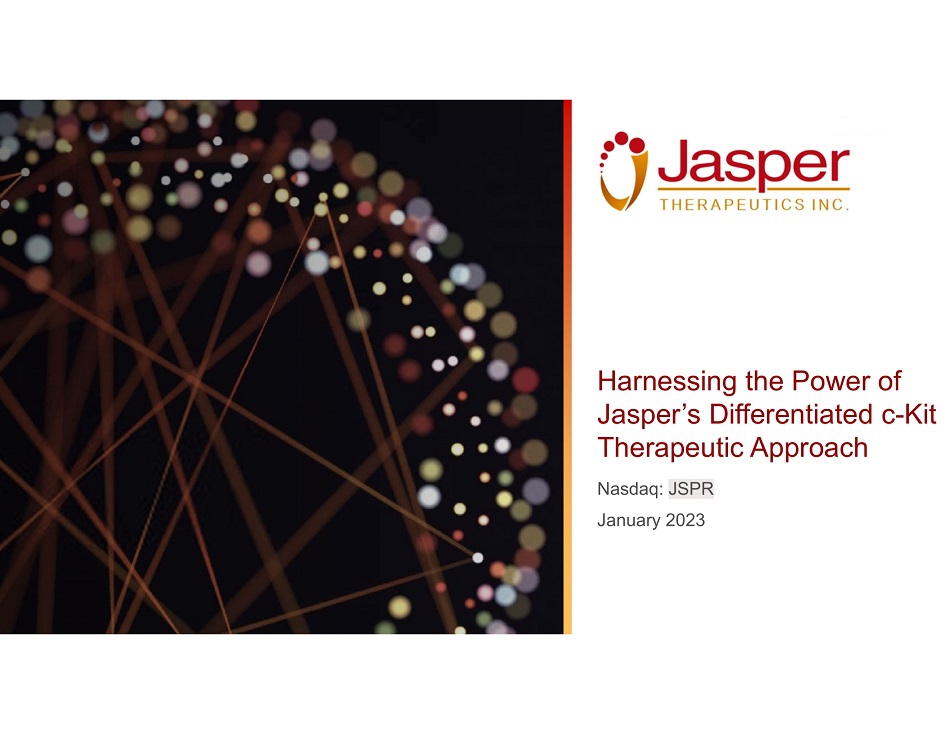
Harnessing the Power of Jasper’s Differentiated c - Kit Therapeutic Approach Nasdaq: JSPR January 2023 Exhibit 99.2
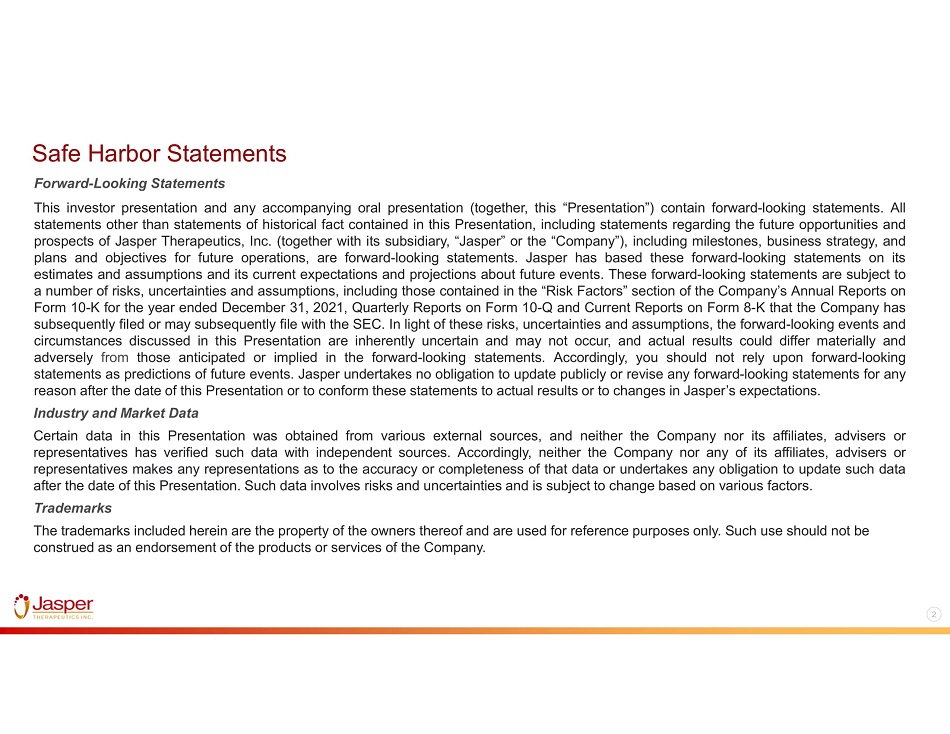
2 Safe Harbor Statements Forward - Looking Statements This investor presentation and any accompanying oral presentation (together, this “Presentation”) contain forward - looking statements . All statements other than statements of historical fact contained in this Presentation, including statements regarding the future opportunities and prospects of Jasper Therapeutics, Inc . (together with its subsidiary, “Jasper” or the “Company”), including milestones, business strategy, and plans and objectives for future operations, are forward - looking statements . Jasper has based these forward - looking statements on its estimates and assumptions and its current expectations and projections about future events . These forward - looking statements are subject to a number of risks, uncertainties and assumptions, including those contained in the “Risk Factors” section of the Company’s Annual Reports on Form 10 - K for the year ended December 31 , 2021 , Quarterly Reports on Form 10 - Q and Current Reports on Form 8 - K that the Company has subsequently filed or may subsequently file with the SEC . In light of these risks, uncertainties and assumptions, the forward - looking events and circumstances discussed in this Presentation are inherently uncertain and may not occur, and actual results could differ materially and adversely from those anticipated or implied in the forward - looking statements . Accordingly, you should not rely upon forward - looking statements as predictions of future events . Jasper undertakes no obligation to update publicly or revise any forward - looking statements for any reason after the date of this Presentation or to conform these statements to actual results or to changes in Jasper’s expectations . Industry and Market Data Certain data in this Presentation was obtained from various external sources, and neither the Company nor its affiliates, advisers or representatives has verified such data with independent sources . Accordingly, neither the Company nor any of its affiliates, advisers or representatives makes any representations as to the accuracy or completeness of that data or undertakes any obligation to update such data after the date of this Presentation . Such data involves risks and uncertainties and is subject to change based on various factors . Trademarks The trademarks included herein are the property of the owners thereof and are used for reference purposes only. Such use shou ld not be construed as an endorsement of the products or services of the Company.
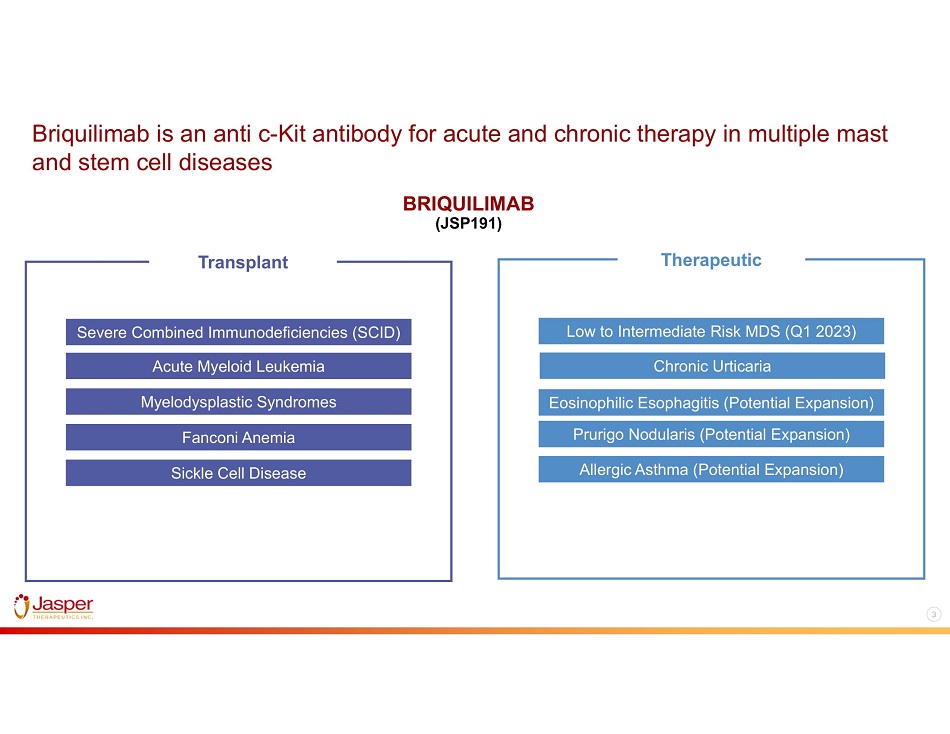
3 Briquilimab is an anti c - Kit antibody for acute and chronic therapy in multiple mast and stem cell diseases BRIQUILIMAB (JSP191) Low to Intermediate Risk MDS (Q1 2023) Eosinophilic Esophagitis (Potential Expansion) Prurigo Nodularis (Potential Expansion) Allergic Asthma (Potential Expansion) Therapeutic Chronic Urticaria Transplant Severe Combined Immunodeficiencies (SCID) Acute Myeloid Leukemia Myelodysplastic Syndromes Fanconi Anemia Sickle Cell Disease
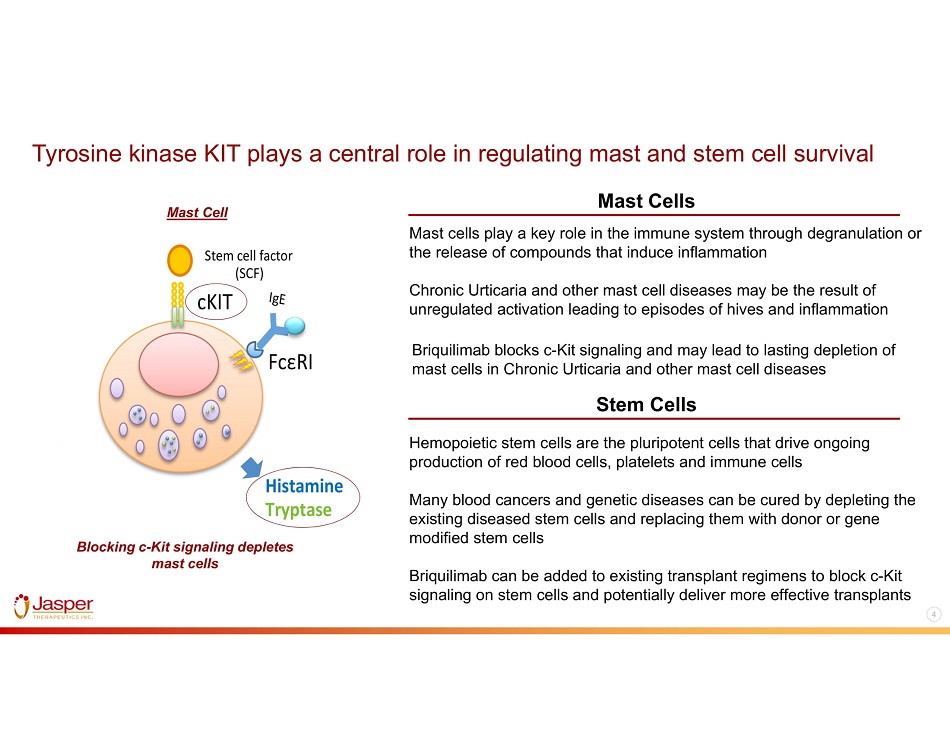
4 Tyrosine kinase KIT plays a central role in regulating mast and stem cell survival Mast cells play a key role in the immune system through degranulation or the release of compounds that induce inflammation Chronic Urticaria and other mast cell diseases may be the result of unregulated activation leading to episodes of hives and inflammation Mast Cells Stem Cells Briquilimab blocks c - Kit signaling and may lead to lasting depletion of mast cells in Chronic Urticaria and other mast cell diseases Blocking c - Kit signaling depletes mast cells Hemopoietic stem cells are the pluripotent cells that drive ongoing production of red blood cells, platelets and immune cells Many blood cancers and genetic diseases can be cured by depleting the existing diseased stem cells and replacing them with donor or gene modified stem cells Briquilimab can be added to existing transplant regimens to block c - Kit signaling on stem cells and potentially deliver more effective transplants Mast Cell
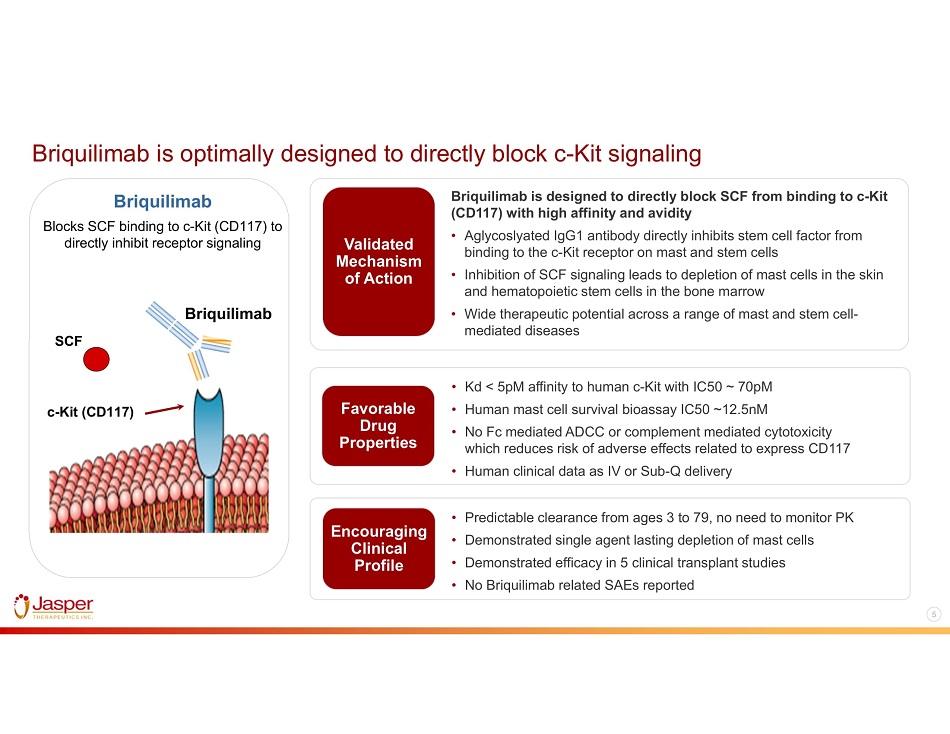
5 SCF c - Kit ( CD117) Briquilimab Briquilimab Blocks SCF binding to c - Kit (CD117) to directly inhibit receptor signaling Validated Mechanism of Action Briquilimab is designed to directly block SCF from binding to c - Kit (CD117) with high affinity and avidity • Aglycoslyated IgG1 antibody directly inhibits stem cell factor from binding to the c - Kit receptor on mast and stem cells • Inhibition of SCF signaling leads to depletion of mast cells in the skin and hematopoietic stem cells in the bone marrow • Wide therapeutic potential across a range of mast and stem cell - mediated diseases Favorable Drug Properties • Kd < 5pM affinity to human c - Kit with IC50 ~ 70pM • Human mast cell survival bioassay IC50 ~12.5nM • No Fc mediated ADCC or complement mediated cytotoxicity which reduces risk of adverse effects related to express CD117 • Human clinical data as IV or Sub - Q delivery Encouraging Clinical Profile • Predictable clearance from ages 3 to 79, no need to monitor PK • Demonstrated single agent lasting depletion of mast cells • Demonstrated efficacy in 5 clinical transplant studies • No Briquilimab related SAEs reported Briquilimab is optimally designed to directly block c - Kit signaling
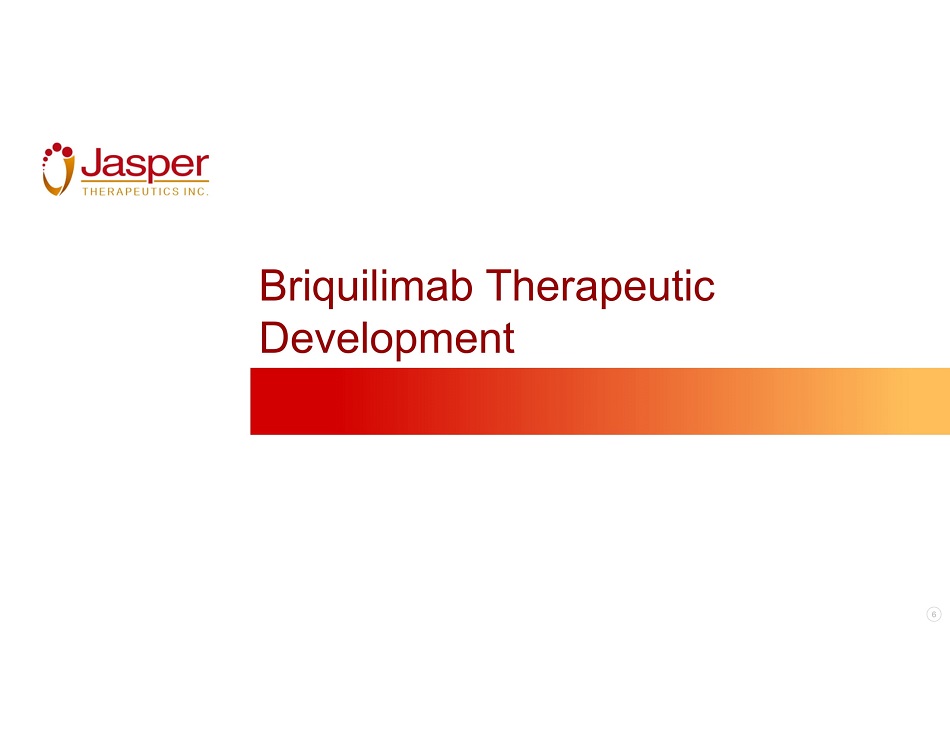
6 Briquilimab Therapeutic Development
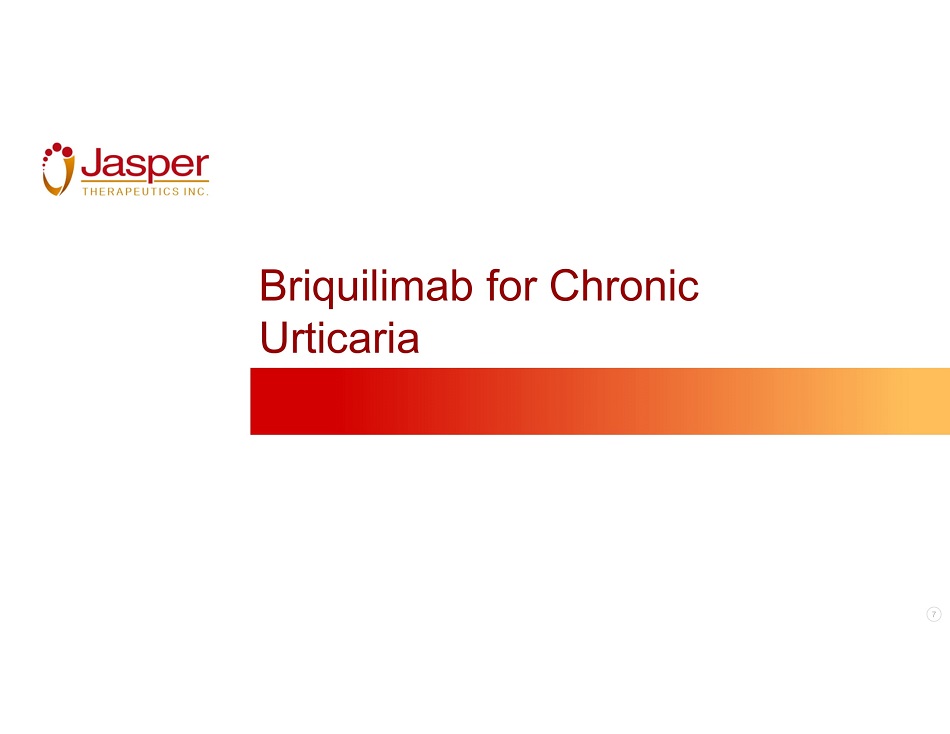
7 Briquilimab for Chronic Urticaria
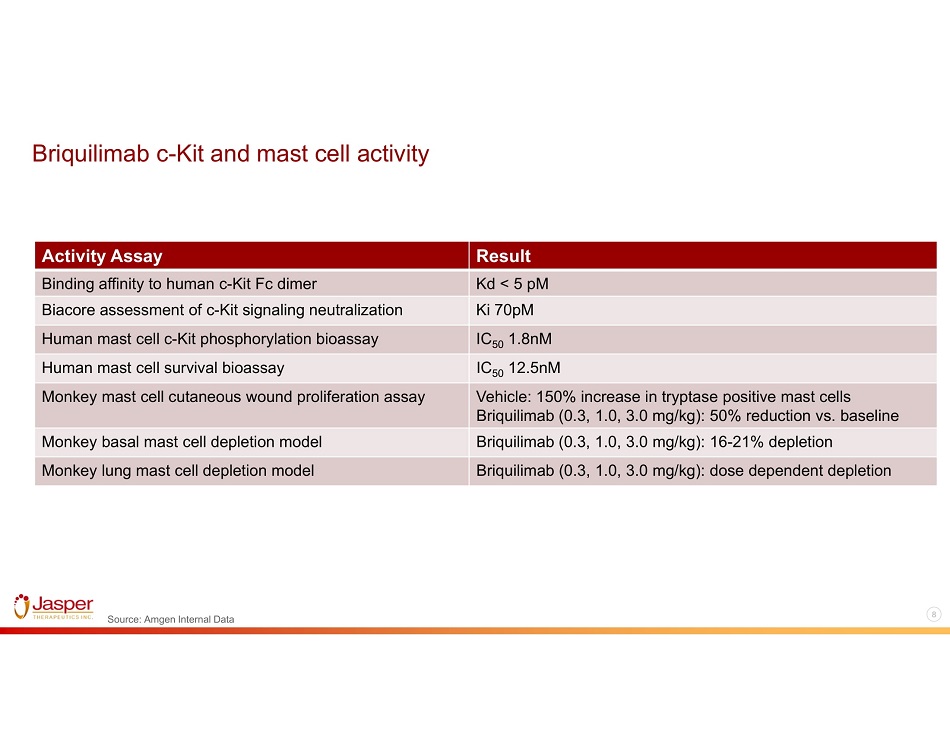
8 Briquilimab c - Kit and mast cell activity Activity Assay Result Binding affinity to human c - Kit Fc dimer Kd < 5 pM Biacore assessment of c - Kit signaling neutralization Ki 70pM Human mast cell c - Kit phosphorylation bioassay IC 50 1.8nM Human mast cell survival bioassay IC 50 12.5nM Monkey mast cell cutaneous wound proliferation assay Vehicle: 150% increase in tryptase positive mast cells Briquilimab (0.3, 1.0, 3.0 mg/kg): 50% reduction vs. baseline Monkey basal mast cell depletion model Briquilimab (0.3, 1.0, 3.0 mg/kg): 16 - 21% depletion Monkey lung mast cell depletion model Briquilimab (0.3, 1.0, 3.0 mg/kg): dose dependent depletion Source: Amgen Internal Data
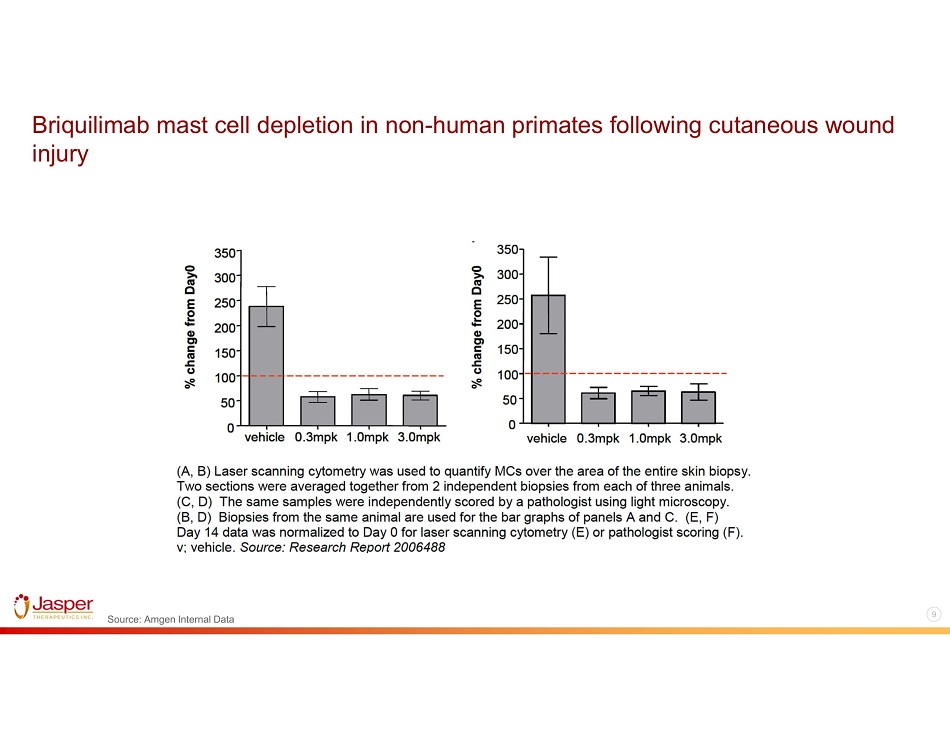
9 Briquilimab mast cell depletion in non - human primates following cutaneous wound injury Source: Amgen Internal Data

10 Briquilimab can be dosed IV or sub - cutaneous Briquilimab IV serum concentrations Time (days) C o n c e n t r a t i o n o f J S P 1 9 1 i n S e r u m ( n g / m L ) 0 7 14 21 1 10 100 1000 10000 100000 -0001 (0.1 mg/kg) -0002 (0.1 mg/kg) -0003 (0.1 mg/kg) -0004 (0.3 mg/kg) -0006 (0.3 mg/kg) -0008 (0.3 mg/kg) -0013 (0.3 mg/kg) -0014 (0.3 mg/kg) -0015 (0.3 mg/kg) -0011 (0.6 mg/kg) -0007 (1 mg/kg) -0009 (1 mg/kg) -0010 (1 mg/kg) -0016 (0.6 mg/kg) Briquilimab SubQ serum concentrations Source: Jasper SCID Study, Amgen Phase I Study Data
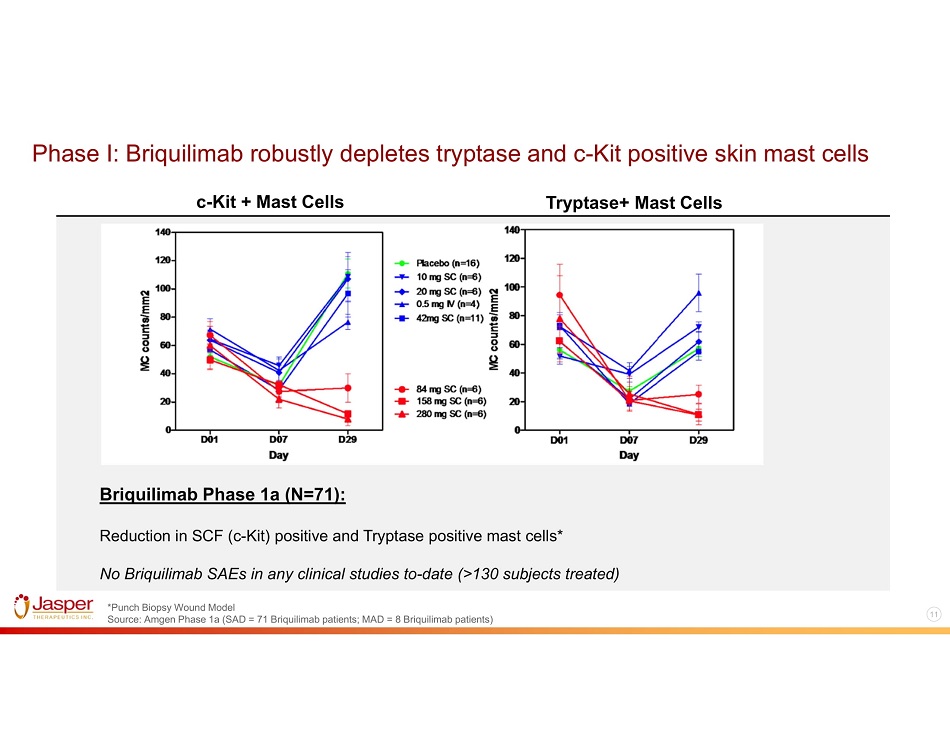
11 Phase I: Briquilimab robustly depletes tryptase and c - Kit positive skin mast cells *Punch Biopsy Wound Model Source: Amgen Phase 1a (SAD = 71 Briquilimab patients; MAD = 8 Briquilimab patients) Briquilimab Phase 1a (N=71): Reduction in SCF (c - Kit) positive and Tryptase positive mast cells* No Briquilimab SAEs in any clinical studies to - date (>130 subjects treated) c - Kit + Mast Cells Tryptase+ Mast Cells
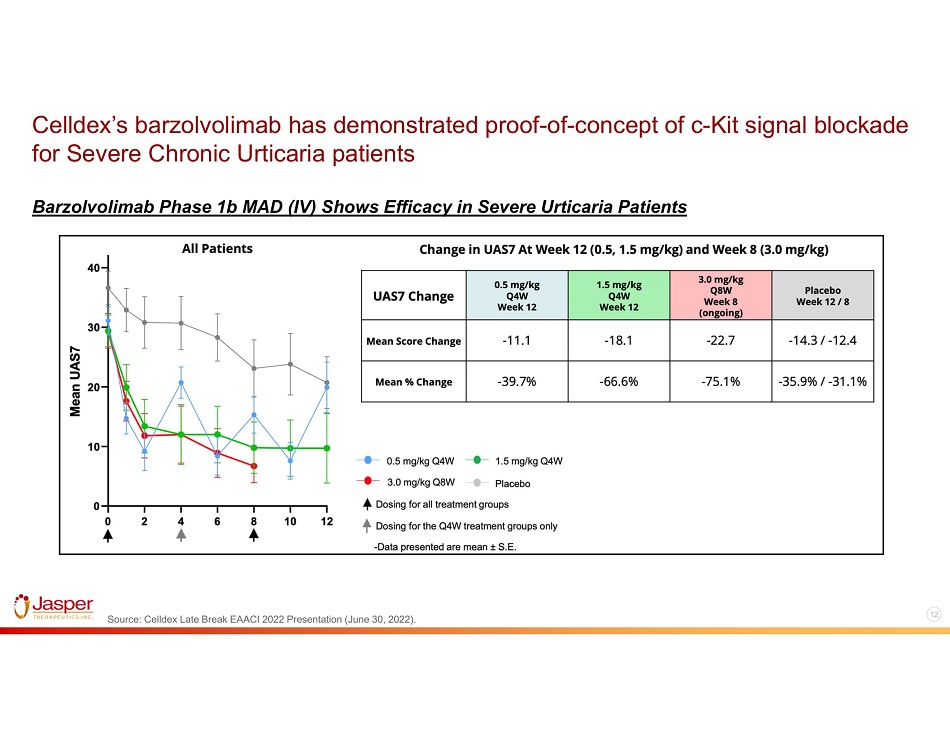
12 Celldex’s barzolvolimab has demonstrated proof - of - concept of c - Kit signal blockade for Severe Chronic Urticaria patients Source: Celldex Late Break EAACI 2022 Presentation (June 30, 2022). Barzolvolimab Phase 1b MAD (IV) Shows Efficacy in Severe Urticaria Patients
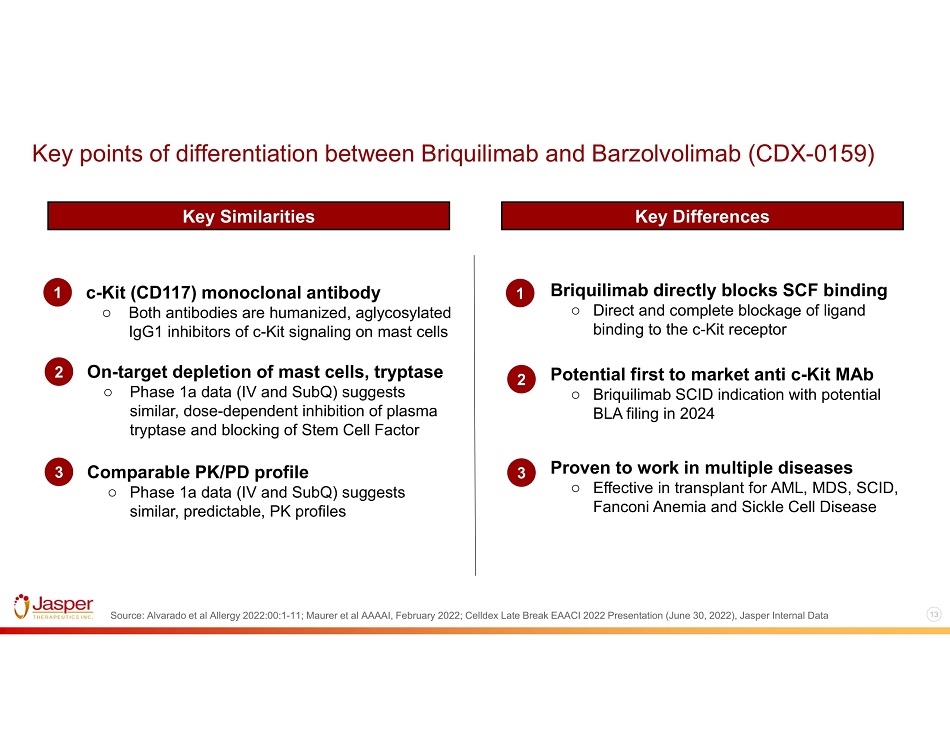
13 Key points of differentiation between Briquilimab and Barzolvolimab (CDX - 0159) Key Similarities Key Differences 1 c - Kit (CD117) monoclonal antibody o Both antibodies are humanized, aglycosylated IgG1 inhibitors of c - Kit signaling on mast cells 2 On - target depletion of mast cells, tryptase o Phase 1a data (IV and SubQ ) suggests similar, dose - dependent inhibition of plasma tryptase and blocking of Stem Cell Factor 3 Comparable PK/PD profile o Phase 1a data (IV and SubQ ) suggests similar, predictable, PK profiles 1 2 3 Potential first to market anti c - Kit MAb o Briquilimab SCID indication with potential BLA filing in 2024 Briquilimab directly blocks SCF binding o Direct and complete blockage of ligand binding to the c - Kit receptor Proven to work in multiple diseases o Effective in transplant for AML, MDS, SCID, Fanconi Anemia and Sickle Cell Disease Source: Alvarado et al Allergy 2022:00:1 - 11; Maurer et al AAAAI, February 2022; Celldex Late Break EAACI 2022 Presentation (June 30, 2022), Jasper Internal Data
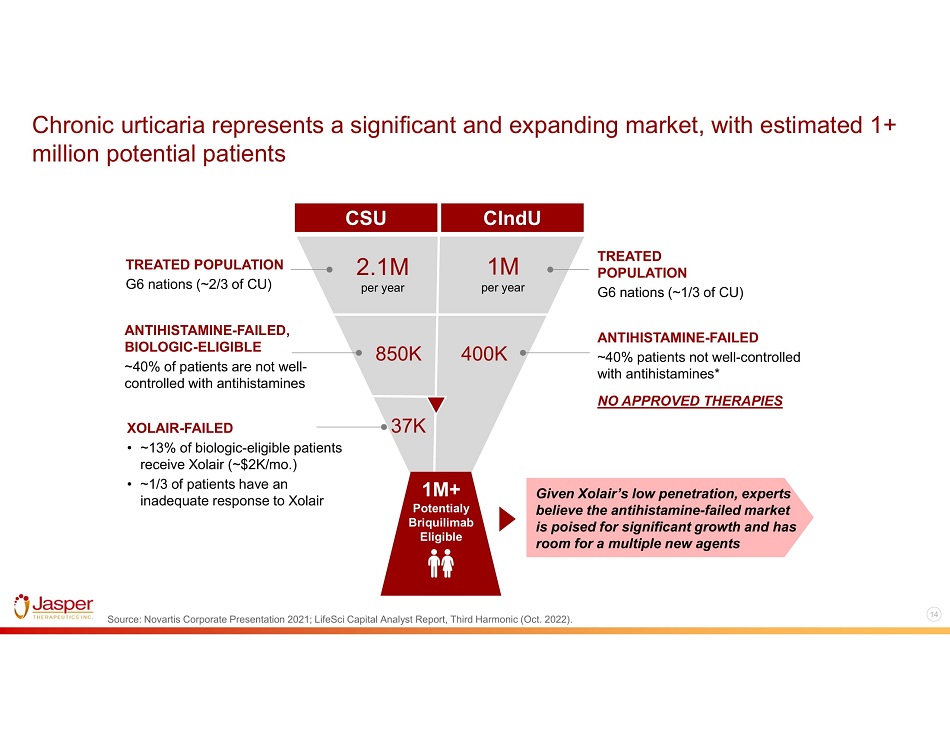
14 Chronic urticaria represents a significant and expanding market, with estimated 1+ million potential patients Given Xolair’s low penetration, experts believe the antihistamine - failed market is poised for significant growth and has room for a multiple new agents CSU CIndU 2.1M per year 1M per year TREATED POPULATION G6 nations (~1/3 of CU) TREATED POPULATION G6 nations (~2/3 of CU) 850K 400K ANTIHISTAMINE - FAILED ~40% patients not well - controlled with antihistamines* ANTIHISTAMINE - FAILED, BIOLOGIC - ELIGIBLE ~40% of patients are not well - controlled with antihistamines XOLAIR - FAILED • ~13% of biologic - eligible patients receive Xolair (~$2K/mo.) • ~1/3 of patients have an inadequate response to Xolair 37K NO APPROVED THERAPIES 1M+ Potentialy Briquilimab Eligible Source: Novartis Corporate Presentation 2021; LifeSci Capital Analyst Report, Third Harmonic (Oct. 2022).
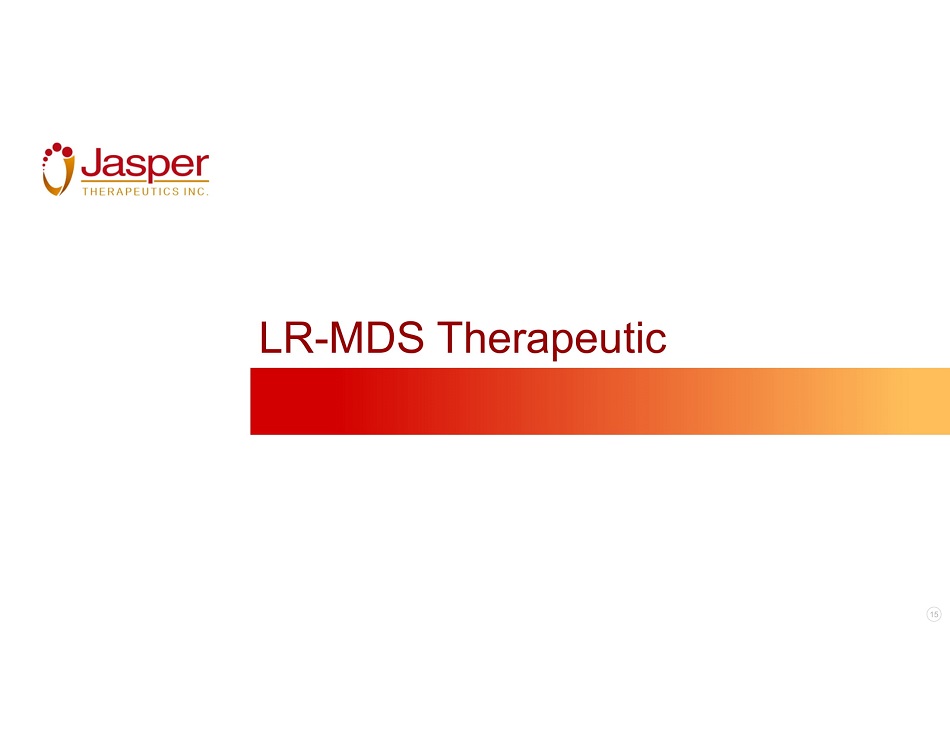
15 LR - MDS Therapeutic
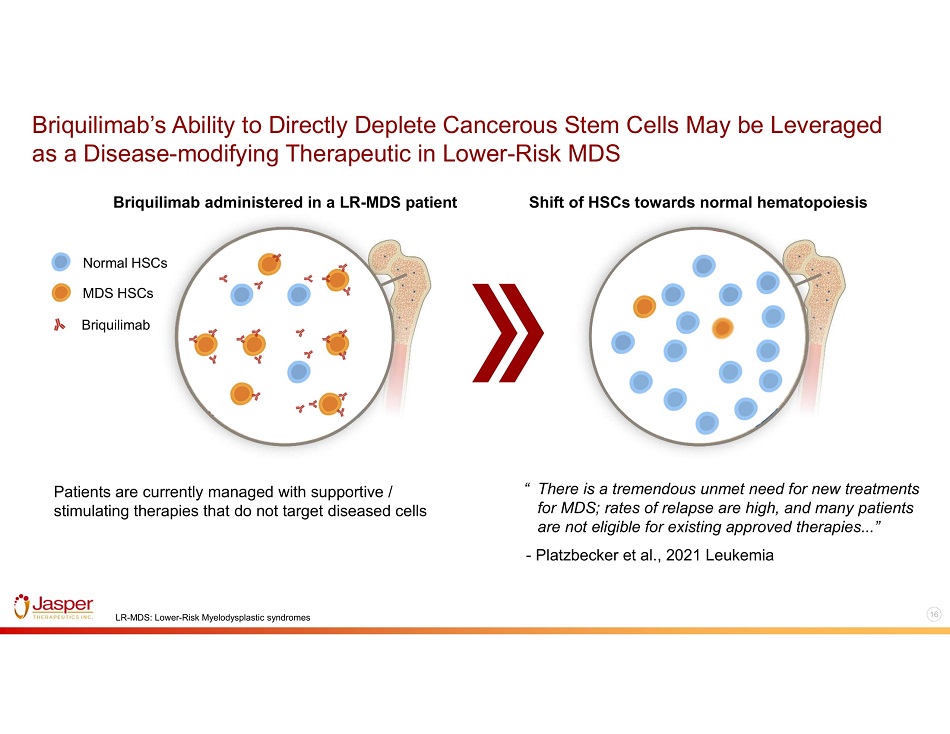
16 Briquilimab’s Ability to Directly Deplete Cancerous Stem Cells May be Leveraged as a Disease - modifying Therapeutic in Lower - Risk MDS LR - MDS: Lower - Risk Myelodysplastic syndromes MDS HSCs Briquilimab Normal HSCs Briquilimab administered in a LR - MDS patient Shift of HSCs towards normal hematopoiesis P atient s are currently managed with supportive / stimulating therapies that do not target diseased cells - Platzbecker et al., 2021 Leukemia “ There is a tremendous unmet need for new treatments for MDS; rates of relapse are high, and many patients are not eligible for existing approved therapies...”
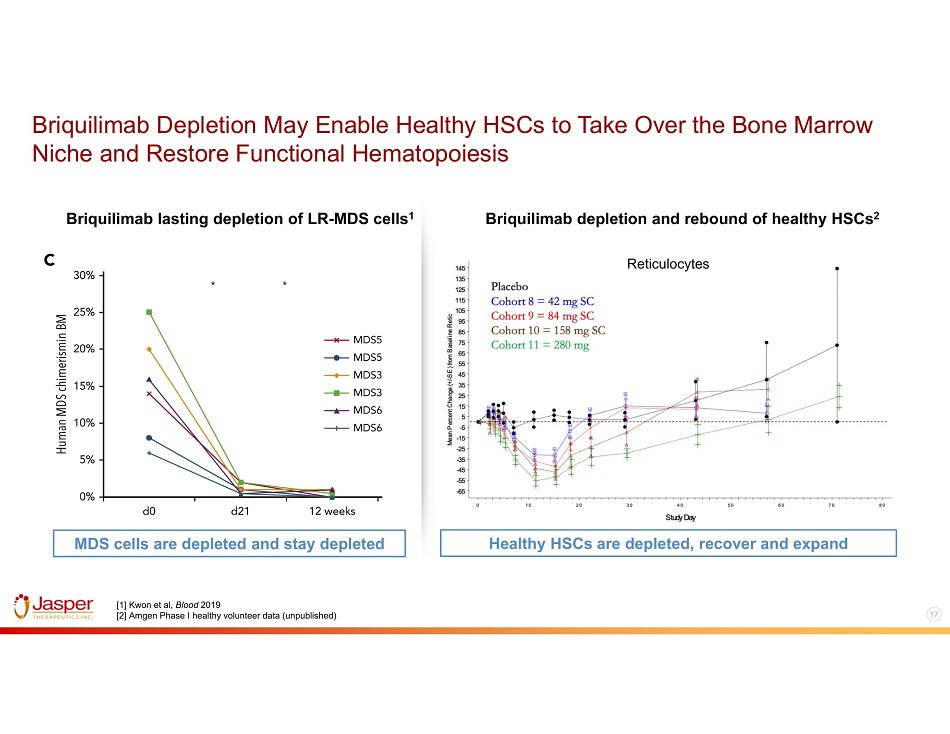
17 Briquilimab Depletion May Enable Healthy HSCs to Take Over the Bone Marrow Niche and Restore Functional Hematopoiesis [1] Kwon et al, Blood 2019 [2] Amgen Phase I healthy volunteer data (unpublished) Briquilimab depletion and rebound of healthy HSCs 2 Reticulocytes Briquilimab lasting depletion of LR - MDS cells 1 MDS cells are depleted and stay depleted Healthy HSCs are depleted, recover and expand
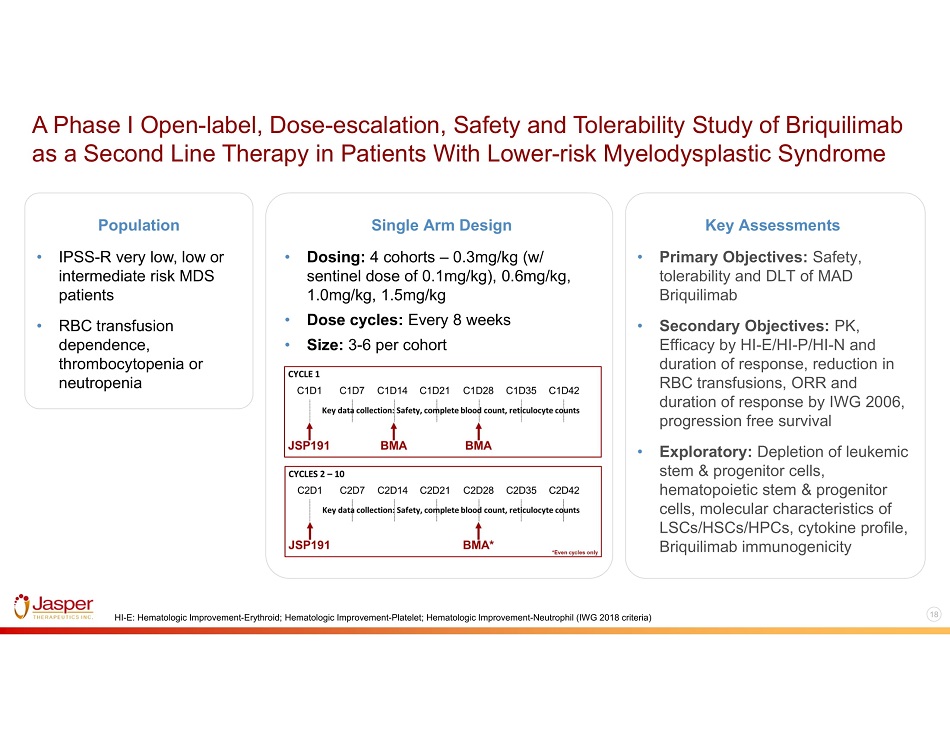
18 A Phase I Open - label, Dose - escalation, Safety and Tolerability Study of Briquilimab as a Second Line Therapy in Patients With Lower - risk Myelodysplastic Syndrome HI - E: Hematologic Improvement - Erythroid; Hematologic Improvement - Platelet; Hematologic Improvement - Neutrophil (IWG 2018 criteria ) • Primary Objectives: Safety, tolerability and DLT of MAD Briquilimab • Secondary Objectives: PK, Efficacy by HI - E/HI - P/HI - N and duration of response, reduction in RBC transfusions, ORR and duration of response by IWG 2006, progression free survival • Exploratory: Depletion of leukemic stem & progenitor cells, hematopoietic stem & progenitor cells, molecular characteristics of LSCs/HSCs/HPCs, cytokine profile, Briquilimab immunogenicity Key Assessments Population • IPSS - R very low, low or intermediate risk MDS patients • RBC transfusion dependence, thrombocytopenia or neutropenia Single Arm Design • Dosing: 4 cohorts – 0.3mg/kg (w/ sentinel dose of 0.1mg/kg), 0.6mg/kg, 1.0mg/kg, 1.5mg/kg • Dose cycles: Every 8 weeks • Size: 3 - 6 per cohort
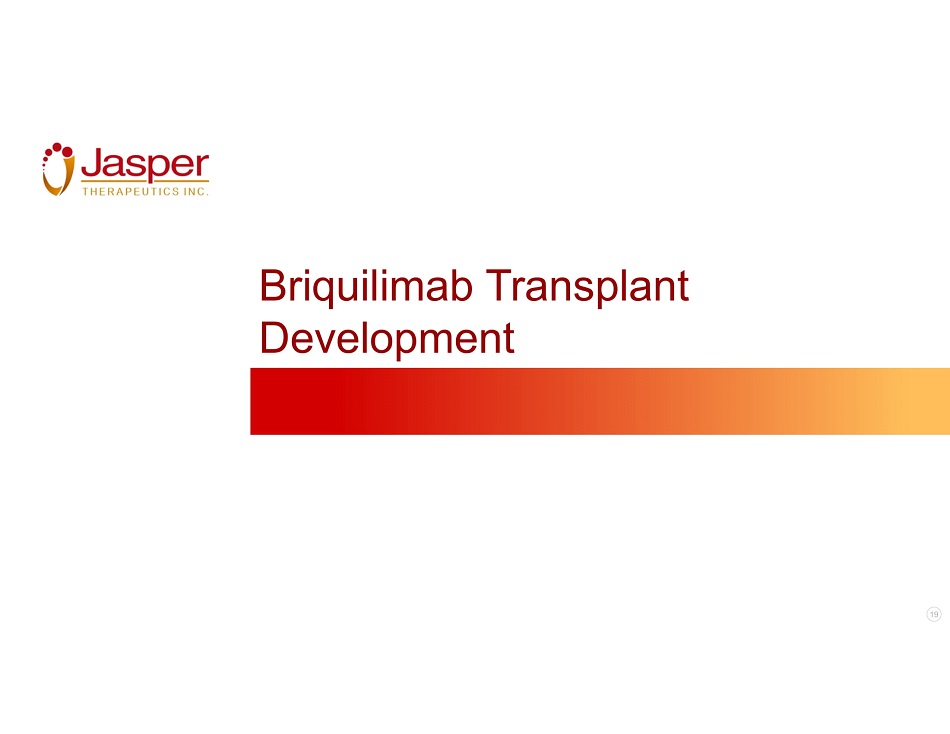
19 Briquilimab Transplant Development
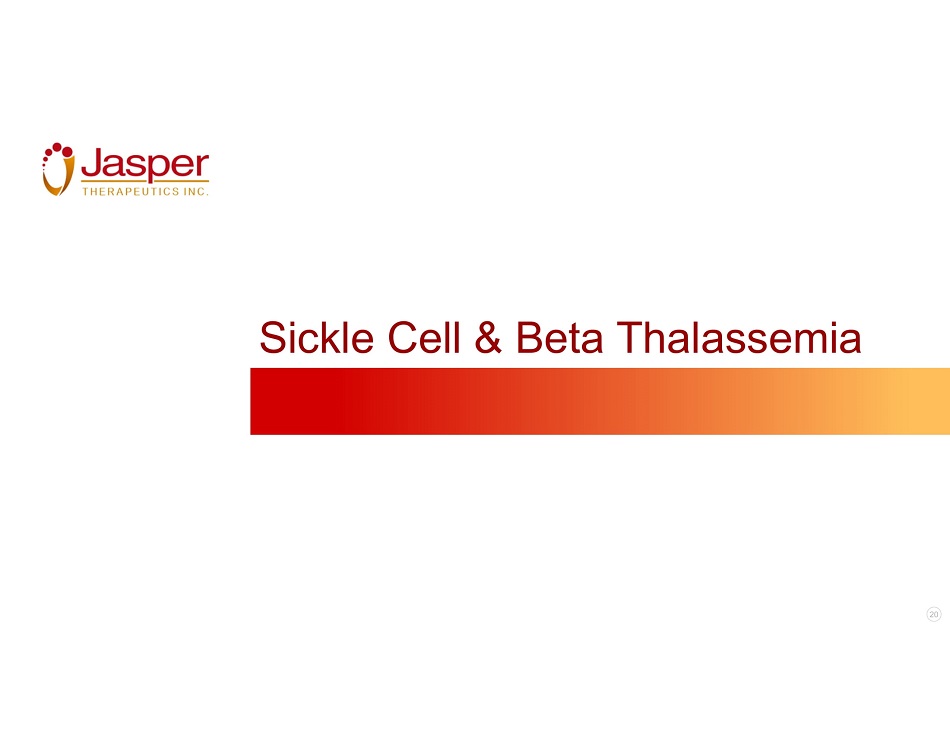
20 Sickle Cell & Beta Thalassemia
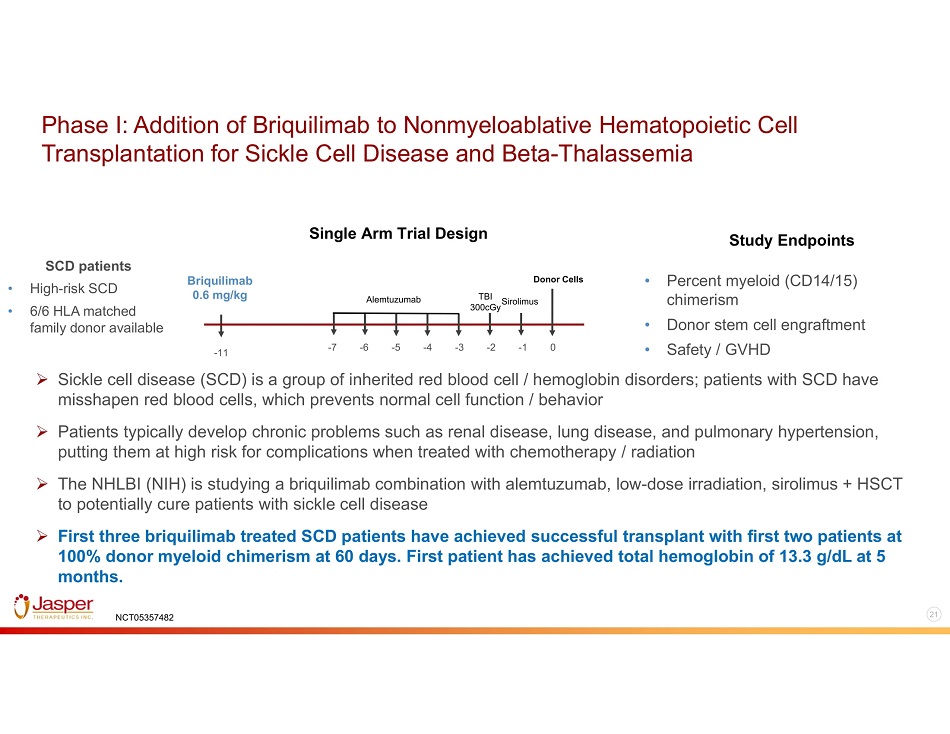
21 » Sickle cell disease (SCD) is a group of inherited red blood cell / hemoglobin disorders; patients with SCD have misshapen red blood cells, which prevents normal cell function / behavior » Patients typically develop chronic problems such as renal disease, lung disease, and pulmonary hypertension, putting them at high risk for complications when treated with chemotherapy / radiation » The NHLBI (NIH) is studying a briquilimab combination with alemtuzumab, low - dose irradiation, sirolimus + HSCT to potentially cure patients with sickle cell disease » First three briquilimab treated SCD patients have achieved successful transplant with first two patients at 100% donor myeloid chimerism at 60 days. First patient has achieved total hemoglobin of 13.3 g/dL at 5 months. Phase I: Addition of Briquilimab to Nonmyeloablative Hematopoietic Cell Transplantation for Sickle Cell Disease and Beta - Thalassemia SCD patients • High - risk SCD • 6/6 HLA matched family donor available • Percent myeloid (CD14/15) chimerism • Donor stem cell engraftment • Safety / GVHD Study Endpoints NCT05357482 Single Arm Trial Design Briquilimab 0.6 mg/kg - 11 Donor Cells Sirolimus 0 Alemtuzumab - 1 - 2 - 3 - 4 - 5 TBI 300cGy - 7 - 6
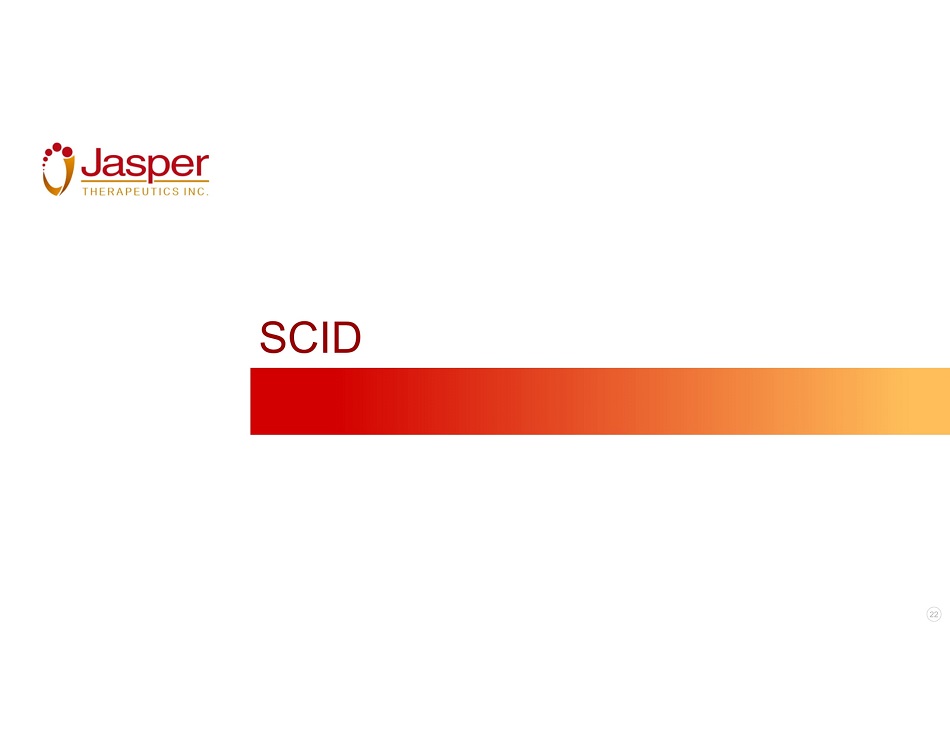
22 SCID
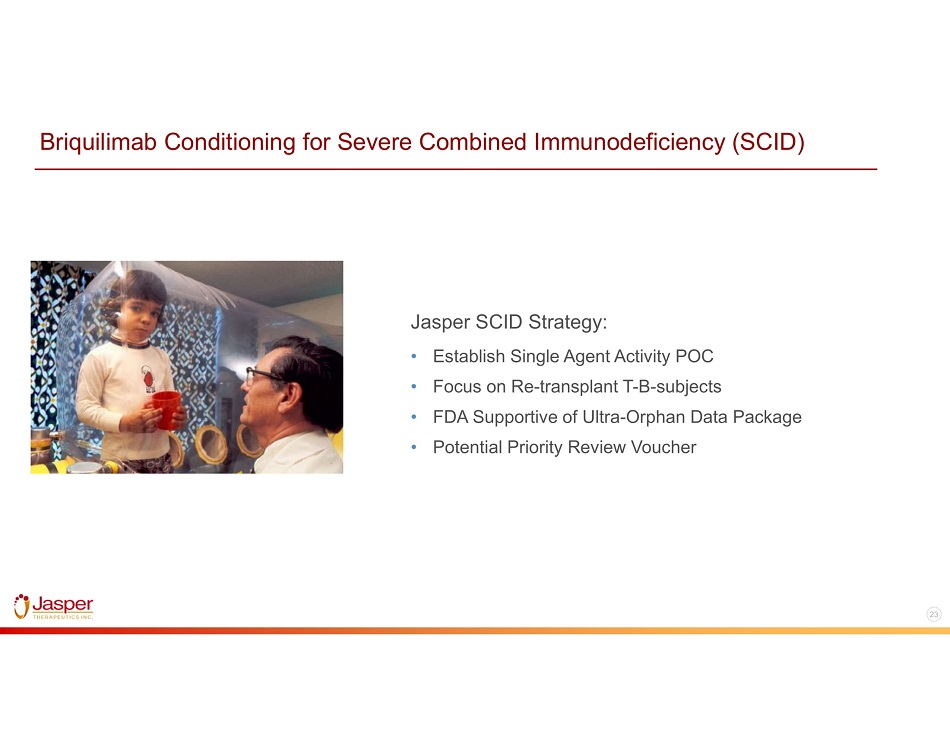
23 Briquilimab Conditioning for Severe Combined Immunodeficiency (SCID) Jasper SCID Strategy: • Establish Single Agent Activity POC • Focus on Re - transplant T - B - subjects • FDA Supportive of Ultra - Orphan Data Package • Potential Priority Review Voucher
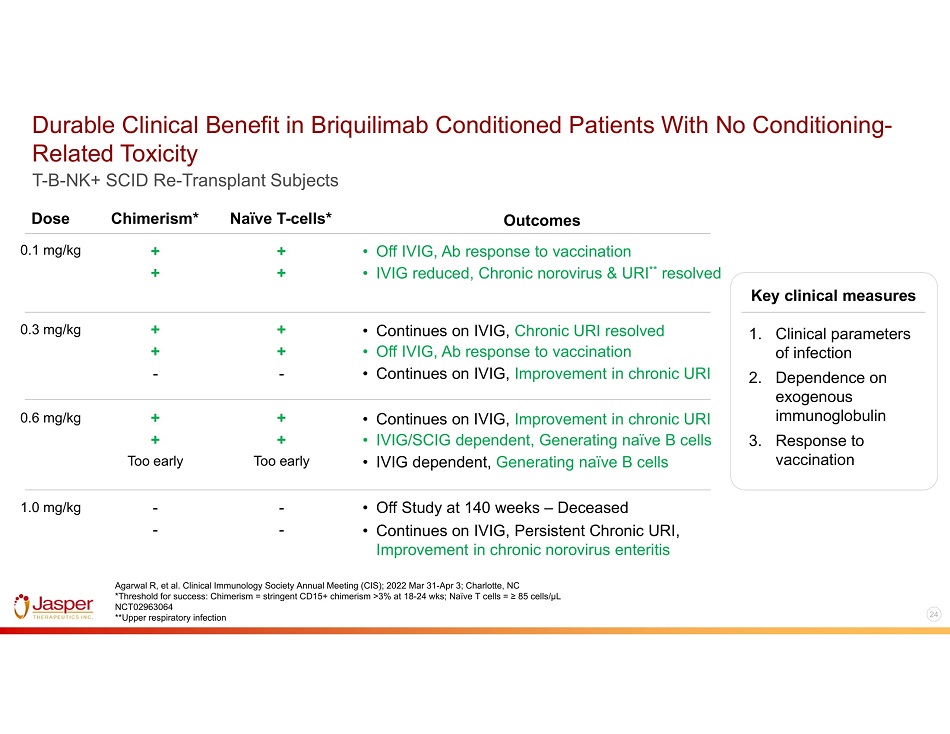
24 Durable Clinical Benefit in Briquilimab Conditioned Patients With No Conditioning - Related Toxicity T - B - NK+ SCID Re - Transplant Subjects Dose Chimerism* 0.1 mg/kg + + Outcomes 0.3 mg/kg 0.6 mg/kg 1.0 mg/kg • Off IVIG, Ab response to vaccination • IVIG reduced, Chronic norovirus & URI ** resolved + + - • Continues on IVIG, Chronic URI resolved • Off IVIG, Ab response to vaccination • Continues on IVIG, Improvement in chronic URI + + Too early • Continues on IVIG, Improvement in chronic URI • IVIG/SCIG dependent, Generating naïve B cells • IVIG dependent, Generating naïve B cells - - • Off Study at 140 weeks – Deceased • Continues on IVIG, Persistent Chronic URI, Improvement in chronic norovirus enteritis Key clinical measures 1. Clinical parameters of infection 2. Dependence on exogenous immunoglobulin 3. Response to vaccination Naïve T - cells* + + + + - + + Too early - - Agarwal R, et al. Clinical Immunology Society Annual Meeting (CIS); 2022 Mar 31 - Apr 3; Charlotte, NC *Threshold for success: Chimerism = stringent CD15+ chimerism >3% at 18 - 24 wks ; Naïve T cells = ≥ 85 cells/ μ L NCT02963064 **Upper respiratory infection
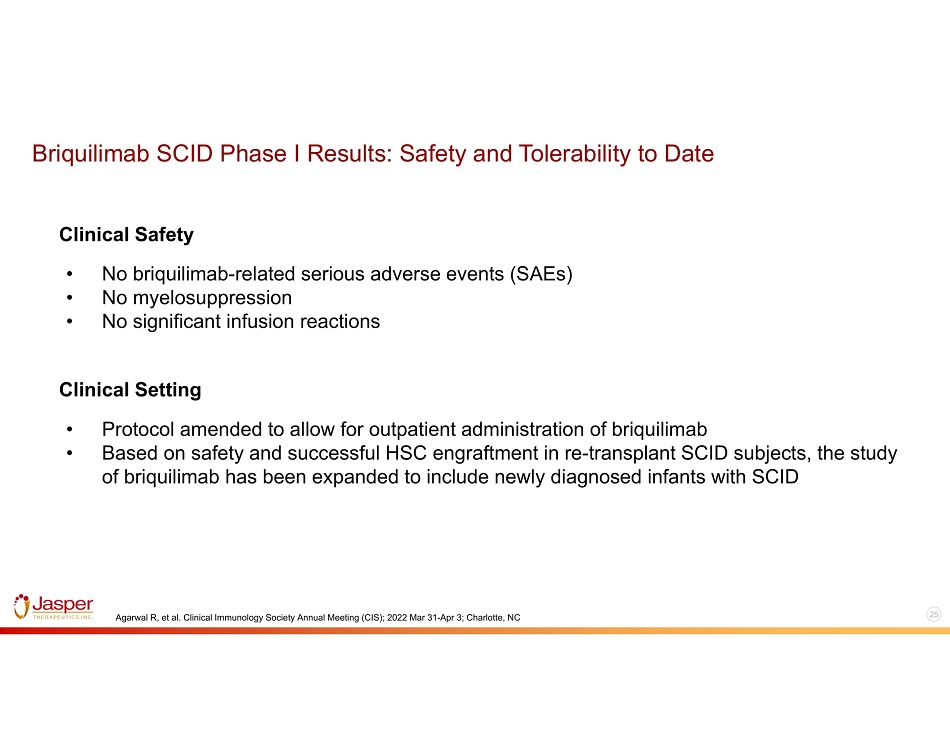
25 Briquilimab SCID Phase I Results: Safety and Tolerability to Date Clinical Safety • No briquilimab - related serious adverse events (SAEs) • No myelosuppression • No significant infusion reactions Agarwal R, et al. Clinical Immunology Society Annual Meeting (CIS); 2022 Mar 31 - Apr 3; Charlotte, NC Clinical Setting • Protocol amended to allow for outpatient administration of briquilimab • Based on safety and successful HSC engraftment in re - transplant SCID subjects, the study of briquilimab has been expanded to include newly diagnosed infants with SCID

26 Potential Near - term Biologics License Application (BLA) and PRV Opportunity for Briquilimab in SCID SCID re - transplant patients are ultra orphan, high unmet need population Focus on current clinical data with briquilimab in 10 SCID re - transplant T - B - patients Generate additional supportive data in existing patients (longitudinal, pre - transplant) and separate natural history data SCID is a lethal genetic immune disorder where HCT is the only proven cure SCID: Severe Combined Immunodeficiency Potential FDA filing strategy Briquilimab granted Rare Pediatric Disease Designation in SCID and may be eligible for PRV with approval
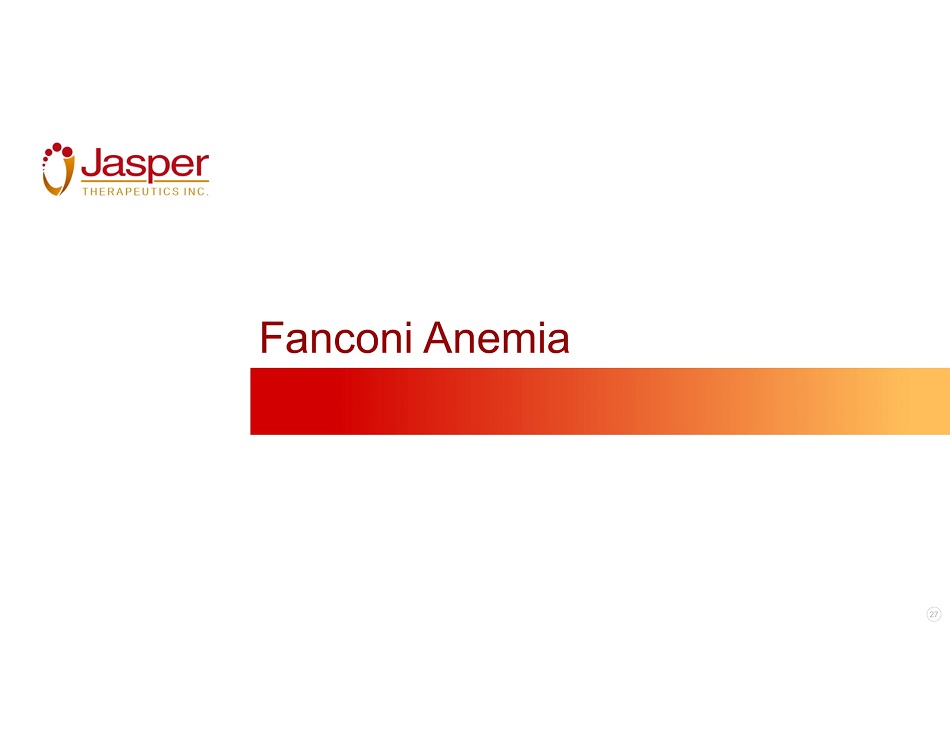
27 Fanconi Anemia
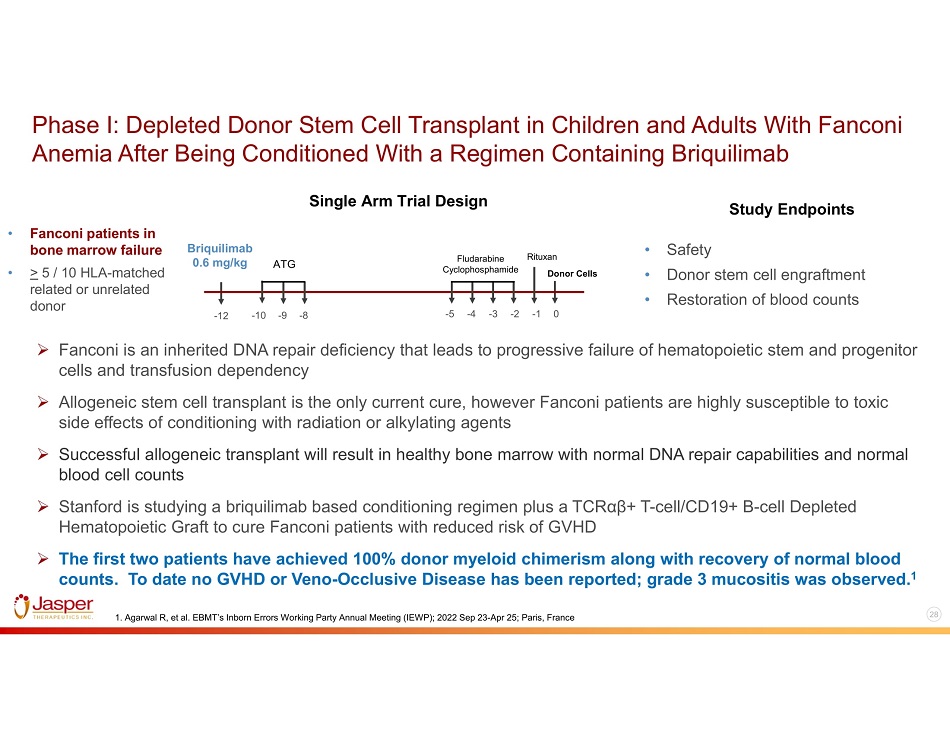
28 Fludarabine Cyclophosphamide » Fanconi is an inherited DNA repair deficiency that leads to progressive failure of hematopoietic stem and progenitor cells and transfusion dependency » Allogeneic stem cell transplant is the only current cure, however Fanconi patients are highly susceptible to toxic side effects of conditioning with radiation or alkylating agents » Successful allogeneic transplant will result in healthy bone marrow with normal DNA repair capabilities and normal blood cell counts » Stanford is studying a briquilimab based conditioning regimen plus a TCR αβ + T - cell/CD19+ B - cell Depleted Hematopoietic Graft to cure Fanconi patients with reduced risk of GVHD » The first two patients have achieved 100% donor myeloid chimerism along with recovery of normal blood counts. To date no GVHD or Veno - Occlusive Disease has been reported; grade 3 mucositis was observed. 1 • Fanconi patients in bone marrow failure • > 5 / 10 HLA - matched related or unrelated donor • Safety • Donor stem cell engraftment • Restoration of blood counts Study Endpoints Single Arm Trial Design 0 - 12 - 10 - 9 - 8 - 1 - 2 - 3 - 4 - 5 Briquilimab 0.6 mg/kg Rituxan ATG Donor Cells 1. Agarwal R, et al. EBMT’s Inborn Errors Working Party Annual Meeting (IEWP); 2022 Sep 23 - Apr 25; Paris, France Phase I: Depleted Donor Stem Cell Transplant in Children and Adults With Fanconi Anemia After Being Conditioned With a Regimen Containing Briquilimab
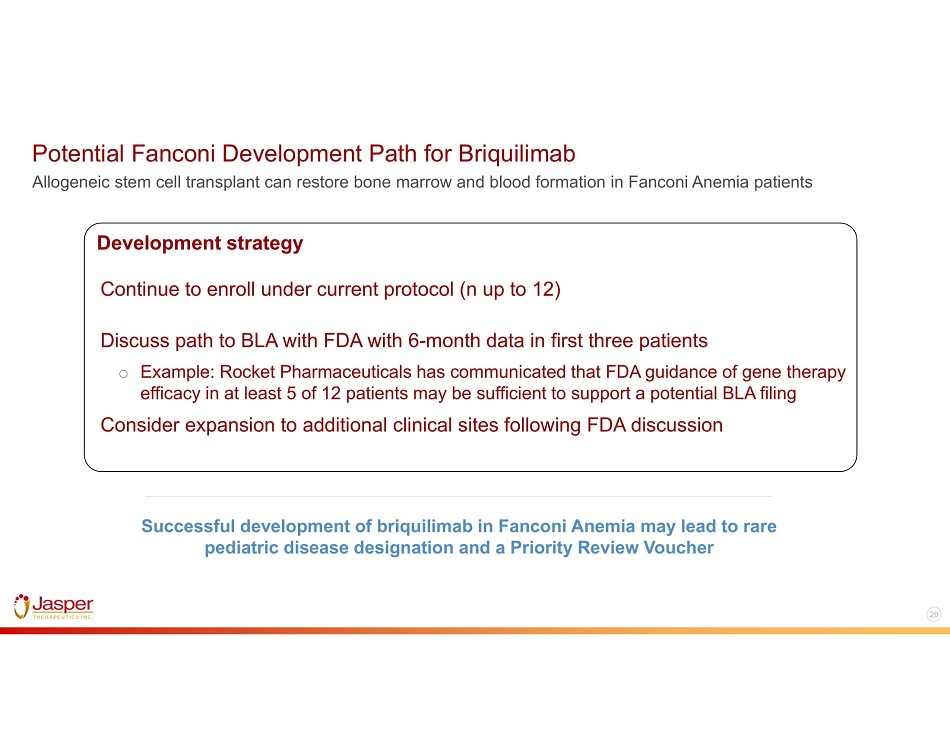
29 Potential Fanconi Development Path for Briquilimab Continue to enroll under current protocol (n up to 12) Discuss path to BLA with FDA with 6 - month data in first three patients o Example: Rocket Pharmaceuticals has communicated that FDA guidance of gene therapy efficacy in at least 5 of 12 patients may be sufficient to support a potential BLA filing Consider expansion to additional clinical sites following FDA discussion Allogeneic stem cell transplant can restore bone marrow and blood formation in Fanconi Anemia patients Development strategy Successful development of briquilimab in Fanconi Anemia may lead to rare pediatric disease designation and a Priority Review Voucher
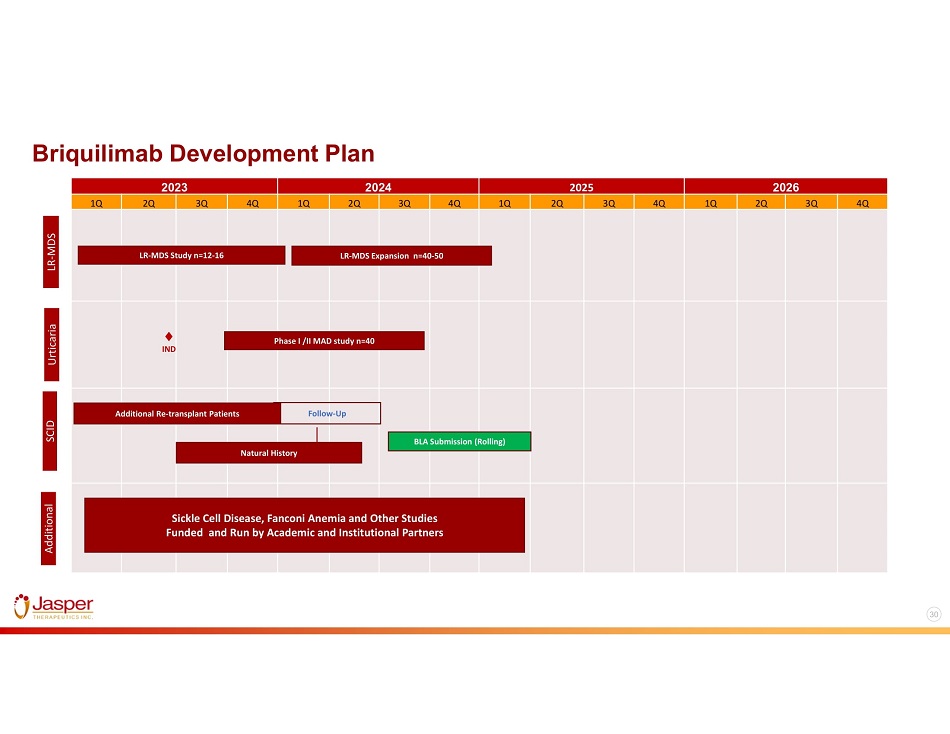
30 Briquilimab Development Plan 2023 2024 2025 2026 1Q 2Q 3Q 4Q 1Q 2Q 3Q 4Q 1Q 2Q 3Q 4Q 1Q 2Q 3Q 4Q LR - MDS LR - MDS Study n=12 - 16 LR - MDS Expansion n=40 - 50 SCID Natural History Follow - Up BLA Submission (Rolling) Urticaria IND Phase I /II MAD study n=40 Additional Sickle Cell Disease, Fanconi Anemia and Other Studies Funded and Run by Academic and Institutional Partners Additional Re - transplant Patients
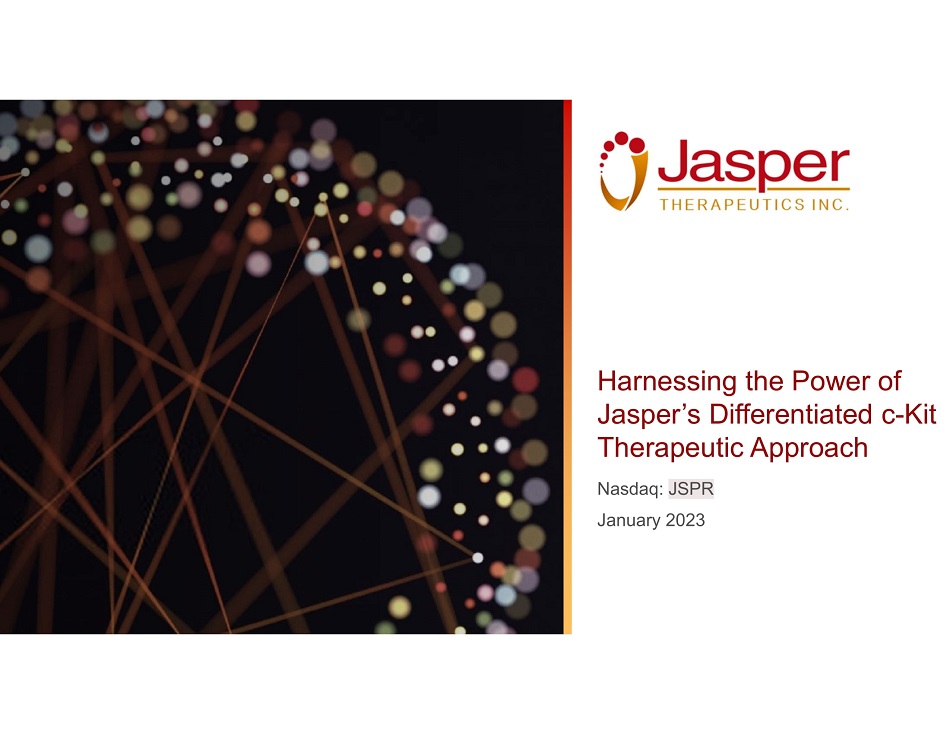
Harnessing the Power of Jasper’s Differentiated c - Kit Therapeutic Approach Nasdaq: JSPR January 2023
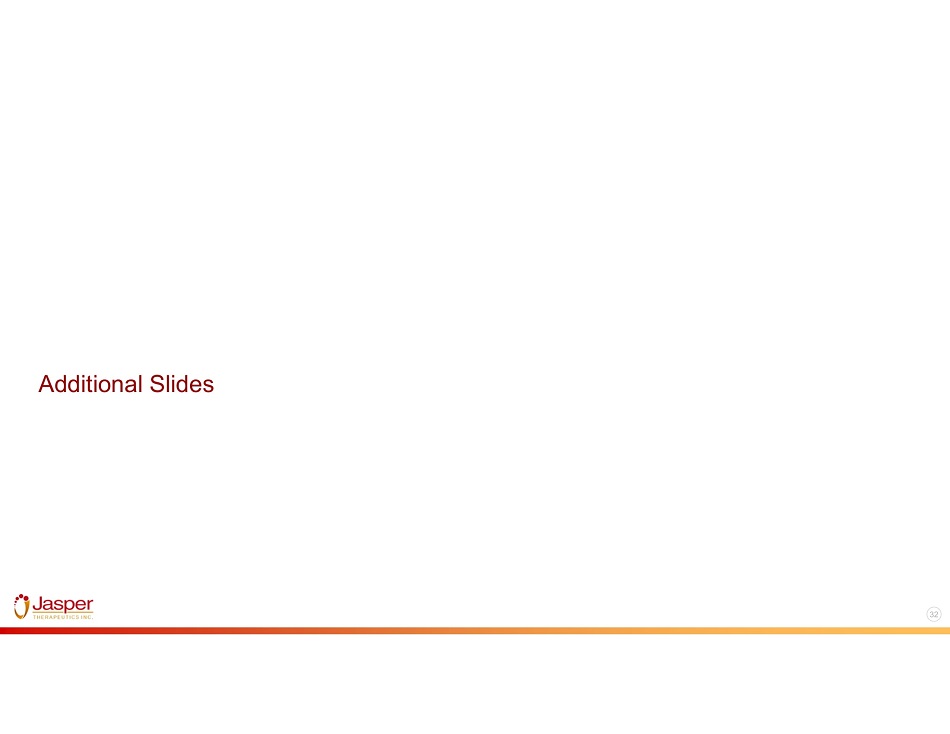
32 Additional Slides
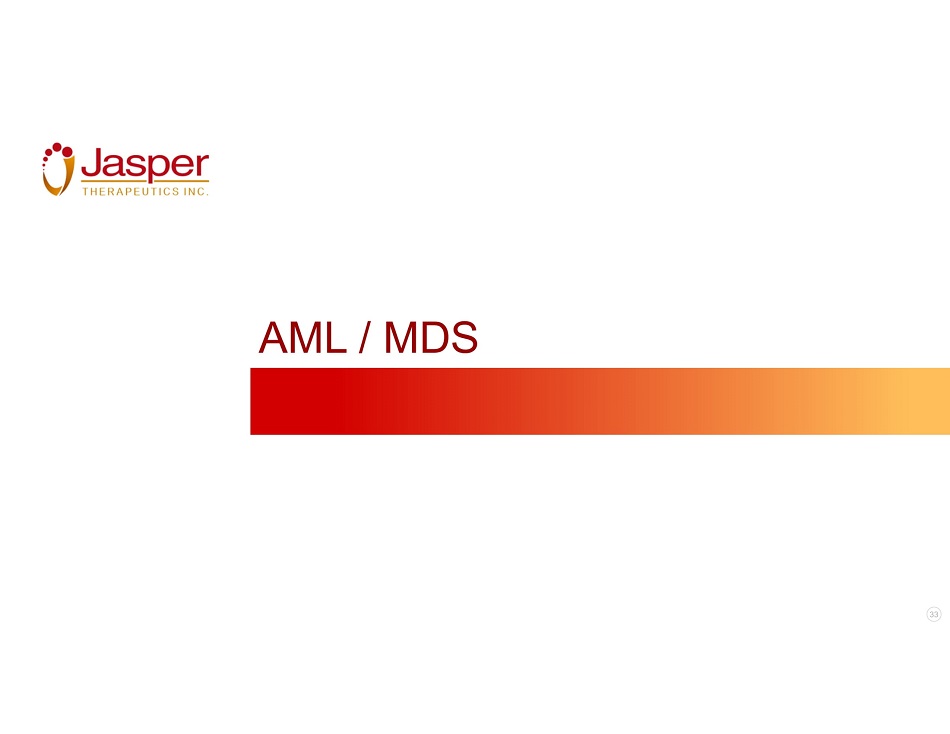
33 AML / MDS

34 AML/MDS Study: Single Agent Briquilimab Depletes Diseased Stem & Progenitor Cells in Bone Marrow in 5 to 7 Days Stem and progenitor cell depletion following briquilimab 0.6 mg/kg single dose in AML/MDS patients Muffly L et al. Tandem Meetings Transplantation and Cellular Therapy (TCT) 2022 April 23 - 26; Salt Lake City, UT Screening Marrow aspirate #2 Marrow aspirates collected at screening and prior to administration of Flu/TBI (prior to projected maximum briquilimab effect) Marrow aspirate #1 Transplant -0% -20% -40% -60% -80% -100% % Depletion of CD34+ CD45RA - CD117+ cells (% Myeloid chimerism at last follow up)
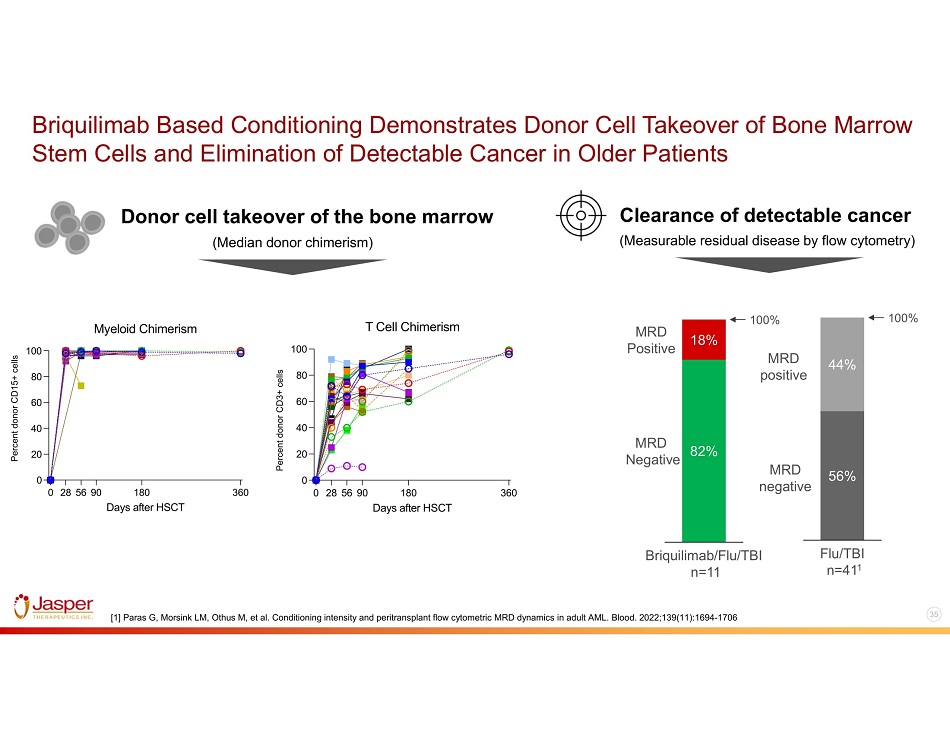
35 Briquilimab Based Conditioning Demonstrates Donor Cell Takeover of Bone Marrow Stem Cells and Elimination of Detectable Cancer in Older Patients (Median donor chimerism) Clearance of detectable cancer Donor cell takeover of the bone marrow (Measurable residual disease by flow cytometry) 82% 18% Briquilimab /Flu/TBI n=11 100% MRD Positive MRD Negative 56% 44% Flu/TBI n=41 1 100% MRD positive MRD negative 0 285690 180 360 0 20 40 60 80 100 Days after HSCT % D o n o r d e r i v e d i n t o t a l P B M C Total Chimerism 0 285690 180 360 0 20 40 60 80 100 Days after HSCT % D o n o r d e r i v e d i n C D 3 + c e l l s T Cell Chimerism 0 285690 180 360 0 20 40 60 80 100 Days after HSCT % D o n o r d e r i v e d i n C D 1 5 + c e l l s Myeloid Chimerism Phase 1a (200 cGy TBI) Phase 1b (300 cGy TBI) 0003 0004 0005 0009 0010 0011 0018 0013 0016 0017 0020 0021 0024 0025 0022 0030 0031 0033 0036 0037 0038 0034 0035 0040 Percent donor CD15+ cells 0 285690 180 360 0 20 40 60 80 100 Days after HSCT % D o n o r d e r i v e d i n t o t a l P B M C Total Chimerism 0 285690 180 360 0 20 40 60 80 100 Days after HSCT % D o n o r d e r i v e d i n C D 3 + c e l l s T Cell Chimerism 0 285690 180 360 0 20 40 60 80 100 Days after HSCT % D o n o r d e r i v e d i n C D 1 5 + c e l l s Myeloid Chimerism Phase 1a (200 cGy TBI) Phase 1b (300 cGy TBI) 0003 0004 0005 0009 0010 0011 0018 0013 0016 0017 0020 0021 0024 0025 0022 0030 0031 0033 0036 0037 0038 0034 0035 0040 Percent donor CD3+ cells [1] Paras G, Morsink LM, Othus M, et al. Conditioning intensity and peritransplant flow cytometric MRD dynamics in adult AML. Blood. 2022;139(11):1694 - 1706
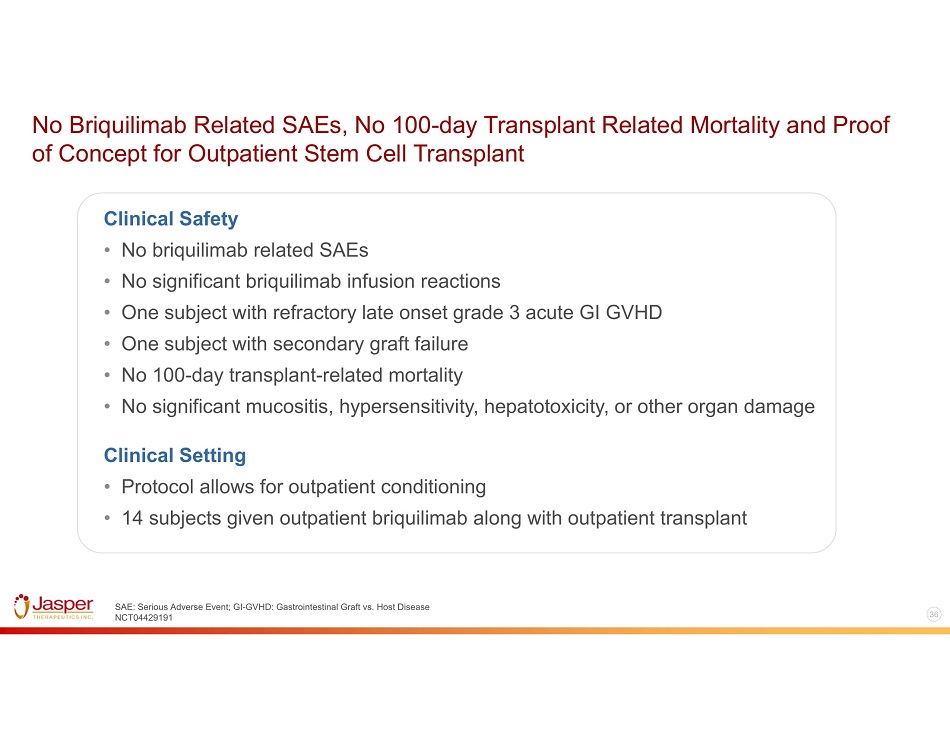
36 No Briquilimab Related SAEs, No 100 - day Transplant Related Mortality and Proof of Concept for Outpatient Stem Cell Transplant Clinical Safety • No briquilimab related SAEs • No significant briquilimab infusion reactions • One subject with refractory late onset grade 3 acute GI GVHD • One subject with secondary graft failure • No 100 - day transplant - related mortality • No significant mucositis, hypersensitivity, hepatotoxicity, or other organ damage Clinical Setting • Protocol allows for outpatient conditioning • 14 subjects given outpatient briquilimab along with outpatient transplant SAE: Serious Adverse Event; GI - GVHD: Gastrointestinal Graft vs. Host Disease NCT04429191
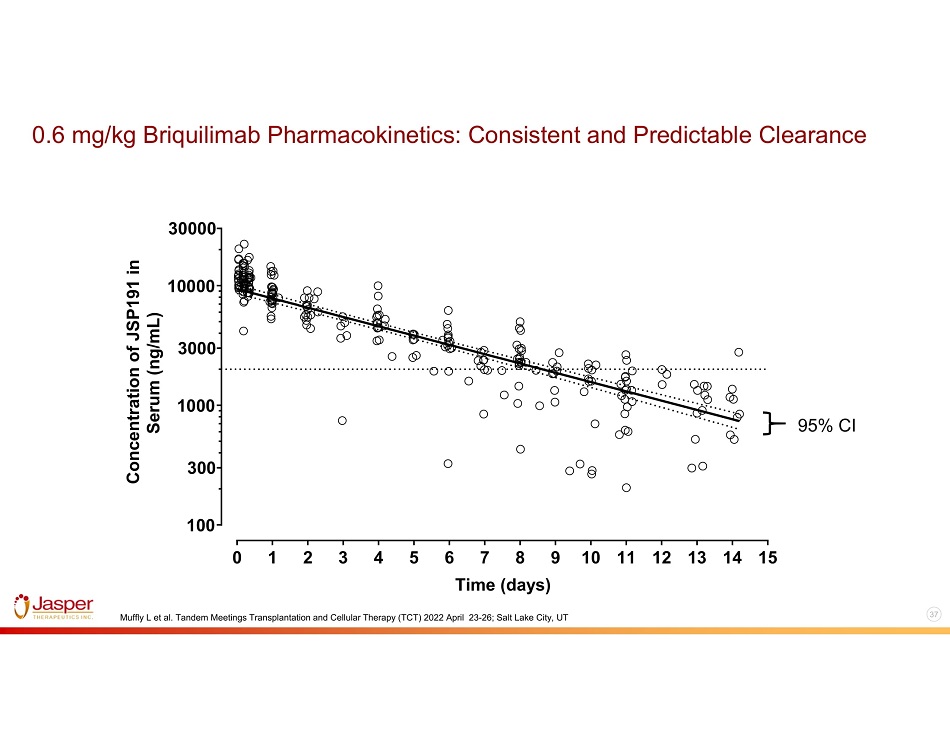
37 0.6 mg/kg Briquilimab Pharmacokinetics: Consistent and Predictable Clearance 0 1 2 3 4 5 6 7 8 9 10 11 12 13 14 15 100 1000 10000 Time (days) Concentration of JSP191 in Serum (ng/mL) 3000 300 30000 Muffly L et al. Tandem Meetings Transplantation and Cellular Therapy (TCT) 2022 April 23 - 26; Salt Lake City, UT 95% CI




































